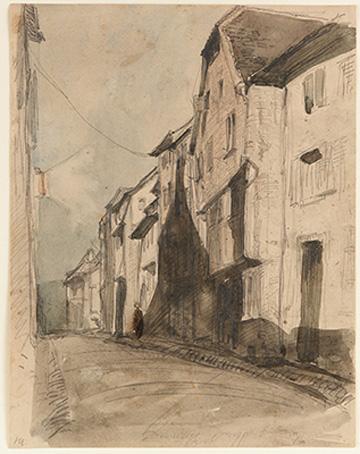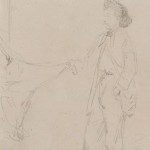James McNeill Whistler Before He Was Whistler At the Freer Gallery of Art
By • January 29, 2014 0 1467

In the summer of 1858, a young James
McNeill Whistler (1834–1903) left Paris
and set off on a walking tour of the
Rhineland, in what would be one of the
most important experiences of his early career.
His goals were to visit Amsterdam—the home of
Rembrandt, an early and lasting influence—and
to make his mark on the artistic world. “Off the
Beaten Path: Early Works by James McNeill
Whistler,” on view through September 28 at
the Freer Gallery of Art, explores the artwork
that the young Whistler created on his journey
and its lasting importance to his subsequent
masterworks.
He never made it to the Netherlands that
summer. However, Whistler created numerous
drawings, etchings and watercolors of the country
life and towns he encountered along the
way. These charmingly casual depictions of
kitchens, innkeepers, doorways and shopkeepers
reflect Whistler’s enthusiasm for his craft as a
young artist. He filled his notebooks with quick,
impromptu sketches, some of which were later
turned into watercolors and etchings in a series
that Whistler referred to as his “French Set.”
A wonderfully infectious dimension to these
drawings is their ability to bridge the expanse of
time between now and the 150 years since their
making. These studies and observations of architecture,
atmosphere, people and places – feverish
sketches that explore the streets, alcoves and
dark cloistered rooms of Europe and the people
who occupy them – show a wide-eyed young
Whistler intoxicated by the romance of the Old
World.
There is at least one major distinction among
these collective
drawings that
separates them
from other artists
– their sheer virtuosity.
It is not
difficult to see
the magnitude of
the young artist’s
abilities, who
would later gain
unprecedented
i n t e r n a t i o n a l
renown. There
are small gestures
and compositions
among
these studies that
are remarkably
powerful.
In one drawing,
a man sits in
a dark room with
his back to the artist in front of a single window
raked with light, like a study for a lost Vemeer.
The exposed beams of the ceiling and the
provencal farmer’s table finish the rough scene
with a dreamy, bohemian dankness that predates
the maudlin allure of Parisian artist Toulouse
Lautrec.
These early works reveal traces of Whistler’s
later, signature style. Recurring motifs, such as
doorways and stylistic choices, including dense
cross-hatching, appear in etchings created nearly
30 years after his journey.
To allow visitors to follow these visual connections
as Whistler’s style matured, the exhibit
includes a selection of etchings from the Venice
(1879-1880) and Amsterdam (1889) sets, groups
of etchings that were published and exhibited
together.
The exhibition is also accompanied by an
online gallery of the exhibition’s objects, a map
showing Whistler’s journey and digital scans of
archival documents from his travels.
Sometimes, it takes a keen eye to recognize
a blossoming artist. With Whistler, however,
it is easy to see that he was destined for greatness.
The Freer Gallery of Art has perhaps the
most impressive collection of the artist’s mature
work, and this exhibition supplements the collection,
offering remarkable insight into the
history, influences, development and mastery of
Whistler’s craft and artistic vision.
For more information visit www.asia.si.edu
- A Street at Saverne (1858), by James McNeill Whistler



